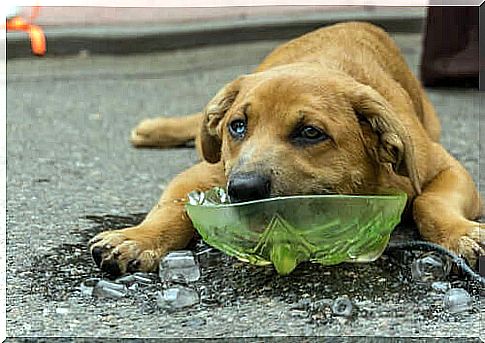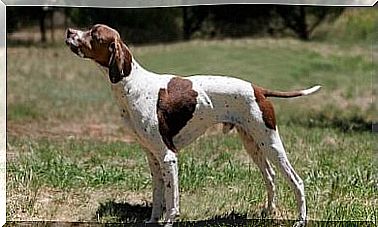The Effect Of Ice On Dogs: Learn More!

Each year, in times of sweltering heat, we tend to offer dogs something refreshing, like ice water or ice cubes. However, is this safe? Today, let’s talk about the effect of ice on dogs.
The myth about the deadly effect of ice on dogs
There is a widespread belief that drinking ice or ice water is dangerous for dogs. Supposedly, it can cause stomach bloating.
This could lead the animals to develop volvogastric dilatation syndrome, a life-threatening condition.
What is volvo-gastric dilatation syndrome?
Volvogastric dilatation syndrome (GVD) is a serious disease, with mortality rates ranging from 10% to 60%. Volvo-gastric dilation occurs due to the accumulation of gases, liquids or a combination of both in the stomach.
Thus, the stomach is distended with gas or liquid and rotation occurs along the axis of the esophagus and the heart. Factors associated with the onset of this syndrome include aerophagia, exercise immediately after eating, and excess food in the stomach.
Which breeds are susceptible to this syndrome?
The animals most commonly affected by DVG are large or giant, deep-chested dogs. As such, this description covers the Great Dane, the Great Dane, the Standard Poodle, and large mixed-breed dogs.
Early diagnosis, medical stabilization, surgical intervention and postoperative monitoring are important factors in reducing the mortality rate.

Can ice ingestion induce this syndrome?
There is no evidence that ice ingestion has anything to do with the development of DVG. The real danger to your dog comes when your pet consumes too much water quickly after swallowing a large amount of air.
Although not a risk factor for DVG, veterinarians do not recommend giving a dog too much ice water after intense physical activity. Think about it: if you are hot and drink a glass of ice water quickly, what happens?
As you may have recalled, water, instead of relieving thirst, brings pain and discomfort. It may not be harmful, but why would you do this to your dog?
In these circumstances, when animals are hot and thirsty, they are likely to drink a lot of water quickly. Drinking lots of water, on the other hand, is actually a known risk factor for stomach bloating.
To keep your dog from bloating, feed several small meals throughout the day instead of one or two large ones. Don’t let him drink too much water at once and avoid exercising for at least an hour after a meal.
What is the effect of ice on dogs’ teeth?
Ice cubes are a common cause of broken teeth in dogs. The larger and more rigid the cube, the greater the chances of this happening.

Chewing on something hard often can cause significant wear and tear on your tooth enamel. One option is to offer smaller chips or cubes to help avoid these problems.
Can ingesting ice in dogs lead to suffocation?
It is possible for the dog to choke on a large ice cube if the animal cannot chew it. Again, it’s a better option to offer small pieces or shavings of ice to avoid this risk.
Animals that have lost teeth or have advanced dental disease have a lower ability to chew and a higher risk of suffocation.
Likewise, dogs that have breathing difficulties or a neurological disorder may be at increased risk of suffocating themselves with an ice cube.
It is always advisable to consult your veterinarian if you are concerned about your dog’s ability to chew and ingest ice cubes.
In case of heat stroke, can ice be used on dogs?
In an overheating situation, experts do not advise using ice. The indication for these cases is to offer cold water, but not ice. The dog must gradually cool down to avoid sudden vasoconstriction.
In heat stroke, it is important to promote the cooling process. It is recommended to wet the dog with water at room temperature — with an emphasis on the belly and back — except in the head area. After that, you should quickly go to the veterinarian’s office.
Even if you can manage your dog’s heatstroke at home, it’s a good idea to go to the vet to make sure your dog hasn’t sustained internal damage.
It is important to recognize the signs of heat stroke: red gums, vomiting, heavy sighs, confusion, difficulty breathing, hot skin and thick saliva.









